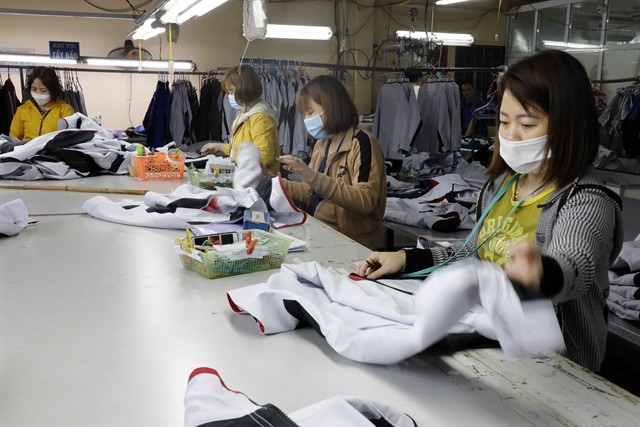
Viet Nam to get highest trade, income gains among RCEP members: WB
Latest
To estimate the economic and distributional impacts of RCEP in Viet Nam, WB constructed a baseline and four alternative scenarios. The baseline reflects the business-as-usual conditions, where the tariff schedules of previous agreements, including the most recent CPTPP, have been implemented, in parallel with the US-China trade war.
 |
| Production of workwear for export. (Photo: VNA) |
In the baseline, between 2020 and 2035, the average trade weighted tariff imposed by Viet Nam declines from 0.8 percent to 0.2 percent, while the tariffs faced by Viet Nam are reduced from 0.6 percent to 0.1 percent. To measure the effects of RCEP, the policy scenario will be compared against this baseline.
The four policy scenarios will measure the RCEP implementation incrementally. The first scenario, the Tariffs scenario, is exclusively the implementation of tariffs according to the RCEP tariffs’ reduction schedules.
In the second scenario, the RCEP scenario, WB implemented reductions of tariffs and of non-tariff measures, including the tariff reduction of 35 percent on agricultural goods; 25 percent on manufacturing goods; and 25 percent on services.
Only when tariff reductions are combined with lower non-trade barriers (NTBs), are exporters able to take full advantage of the preferential rates under liberal Rule of Origin (ROO).
WB assumed that with the ROO regime, the third scenario, trade costs among its members are reduced by 1 percent over the implementation period of 2022-2035. However, in WB's simulations, implementation of ROO policy is costless, resulting in upper bound estimates of potential gains.
For the final shock, the productivity kick scenario, an increase of productivity, as the result of a higher degree of openness and falling trade costs, is implemented.
Viet Nam’s real income and trade expand faster than the baseline in the scenarios with tariffs, non-tariff measure reductions and rules of origin, and in the productivity kick scenario.
“In the productivity kick scenario, where a productivity shock is included, Viet Nam has the highest gains of all RCEP member countries. Real income increases by 4.9 percent relative to the baseline, higher than the gains for the bloc as a whole, where real income increases by 2.5 percent", WB reported.
“Trade also increases the most in this scenario, with exports expanding by 11.4 percent and imports by 9.2 percent, relative to the baseline".
In the baseline, which incorporates long-term trends and accounts for all the current tariff liberalisation commitments within the region (except RCEP), real income in Viet Nam is expected to grow 112.7 percent between 2020 and 2035, with exports and imports increasing by 155.5 percent and 134.8 percent, respectively.
With implementation of RCEP, when rules of origin and productivity are included on top of tariffs and non-tariff measures reductions, real income grows faster, with an increase of 123.1 percent between 2020 and 2035.
The benefits of the implementation of these measures are also reflected in trade, with exports and imports growing 182.5 percent and 155.5 percent, respectively, and between the same period.
In the scenario where only the tariff reduction is implemented, the impact on Viet Nam’s economy is negligible, with real income close to zero. Trade too sees a small reduction relative to the baseline, with both exports and imports declining by 0.3 percent.
“With the implementation of RCEP, the market for Vietnam will expand, particularly to China, where Vietnam does not currently possess any trade agreement. Gains in the productivity kick scenario are concentrated mostly in the manufacturing sectors, in particular wearing apparel, electrical equipment, and textiles,” WB reported.
“Some sectors will suffer losses with the implementation of the agreement, due to a redistribution of resources to more productive sectors.”
The COVID-19 pandemic has taken a high toll in human and economic terms. RCEP could help cushion the negative effects of COVID-19 on economic growth by supporting regional trade and value chains, according to this report.
In the medium/long run, RCEP would increase the resilience of its members, it would make them better prepared in the face of future shocks by enhancing regional collaboration, reducing trade costs, and further diversifying their economies. RCEP offers an opportunity to boost growth and support recovery from the COVID-19 pandemic.
























